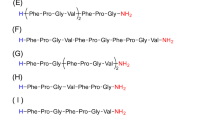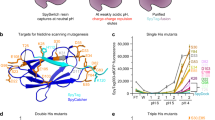Abstract
Elastin-like polypeptides (ELPs) undergo a reversible, inverse phase transition. Below their transition temperature (Tt), ELPs are soluble in water, but when the temperature is raised above Tt, phase transition occurs, leading to aggregation of the polypeptide. We demonstrate a method for purification of soluble fusion proteins incorporating an ELP tag. Advantages of this method, termed "inverse transition cycling," include technical simplicity, low cost, ease of scale-up, and capacity for multiplexing. More broadly, the ability to environmentally modulate the physicochemical properties of recombinant proteins by fusion with ELPs will allow diverse applications in bioseparation, immunoassays, biocatalysis, and drug delivery.
This is a preview of subscription content, access via your institution
Access options
Subscribe to this journal
Receive 12 print issues and online access
$209.00 per year
only $17.42 per issue
Buy this article
- Purchase on Springer Link
- Instant access to full article PDF
Prices may be subject to local taxes which are calculated during checkout



Similar content being viewed by others
References
Nilsson, B., Forsberg, G., Moks, T., Hartmanis, M. & Uhlén, M. Fusion proteins in biotechnology and structural biology. Curr. Opin. Struct. Biol. 2, 569–575 (1992).
Uhlén, M. & Moks, T. Gene fusions for purpose of expression: an introduction. Methods Enzymol. 195, 129–143 (1990).
Maina, C.V. et al. An Escherichia coli vector to express and purify foreign proteins by fusion to and separation from maltose binding protein. Gene 74, 365–373 (1988).
Smith, D.B. & Johnson, K.S. Single-step purification of polypeptides expressed in Escherichia coli as fusions with glutathione S-transferase. Gene 67, 31–40 (1988).
Tsao, K.W., deBarbieri, B., Hanspeter, M. & Waugh, D.W. A versatile plasmid expression vector for the production of biotinylated proteins by site-specific, enzymatic modification in Escherichia coli. Gene 169, 59–64 (1996).
Smith, P.A. et al. A plasmid expression system for quantitative in vivo biotinylation of thioredoxin fusion proteins in Escherichia coli. Nucleic Acids Res. 26, 1414–1420 (1998).
LaVallie, E.R. et al. A thioredoxin gene fusion expression system that circumvents inclusion body formation in the E. coli cytoplasm. Bio/Technology 11, 187–193 (1993).
Ong, E. et al. The cellulose-binding domains of cellulases: tools for biotechnology. Trends Biotechnol. 7, 239–243 (1989).
Smith, M.C., Furman, T.C., Ingolia, T.D. & Pidgeon, C. Chelating peptide-immobilized metal ion affinity chromatography. J. Biol. Chem. 263, 7211–7215 (1988).
Kim, J-S. & Raines, R.T. Ribonuclease S-peptide as a carrier in fusion proteins. Protein. Sci. 2, 348–356 (1993).
Su, X., Prestwood, A.K. & McGraw, R.A. Production of recombinant porcine tumor necrosis factor alpha in a novel E. coli expression system. Biotechniques 13, 756–762 (1992).
Nilsson, J., Ståhl, S., Lundeberg, J., Uhlén, M. & Nygren, P.Å. Affinity fusion strategies for detection, purification, and immobilization of recombinant proteins. Protein Expr. Purif. 11, 1–16 (1997).
Urry, D.W. Entropic elastic processes in protein mechanisms. I. Elastic structure due to an inverse temperature transition due to internal chain dynamics. J. Protein. Chem. 7, 1–34 (1988).
Urry, D.W. Free energy transduction in polypeptides and proteins based on inverse temperature transitions. Prog. Biophys. Mol. Biol. 57, 23–57 (1992).
Urry, D.W. Physical chemistry of biological free energy transduction as demonstrated by elastic protein-based polymers. J. Phys. Chem. B 101, 11007–11028 (1997).
McPherson, D.T., Xu, J. & Urry, D.W. Product purification by reversible phase transition following Escherichia coli expression of genes encoding up to 251 repeats of the elastomeric pentapeptide GVGVP. Protein Expr. Purif. 7, 51–57 (1996).
Hoffman. A.S. Applications of thermally-reversible polymers and hydrogels in therapeutics and diagnostics. J. Controlled Release 6, 297–305 (1987).
Chen, J.P. & Hoffman A.S. Protein-polymer conjugates II. Affinity precipitation separation of immunogammaglobulin by a poly(N-isopropylacrylamide)-protein A conjugate. Biomaterials 11, 631–634 (1990).
Chilkoti, A., Chen, G-H., Stayton, P.S. & Hoffman, A.S. Site-specific conjugation of a temperature-sensitive polymer to a genetically-engineered protein. Bioconjugate Chem. 5, 504–507 (1994).
Urry, D.W. et al. Temperature of polypeptide inverse temperature transition depends on mean residue hydrophobicity. J. Am. Chem. Soc. 113, 4346–4348 (1991).
Urry, D.W., Trapane, T.L. & Prasad, K.U. Phase-structure transitions of the elastin polypentapeptide-water system within the framework of composition-temperature studies. Biopolymers 24, 2345–2356 (1985).
Vertesy, L., Oeding, V., Bender, R., Zepf, K. & Nesemann, G. Tendamistat (HOE 467), a tight-binding alpha-amylase inhibitor from Streptomyces tendae 4158. Eur. J. Biochem. 141, 505–512 (1984).
Porath, J. Immobilized metal ion affinity chromatography. Prot. Expr. Purif. 3, 262–282 (1992).
Coligan, J.E., Dunn, B.M., Ploegh, H.L., Speicher, D.W. & Wingfield, P.T. Current protocols in protein science. (John Wiley & Sons, New York; 1995).
Hartmeier, W. Immobilized biocatalysts. (Springer-Verlag, Berlin; 1988).
Diamandis, E.P. & Christopoulos, T.K. Immunoassay. (Academic Press, San Diego, CA; 1996).
Dewhirst, M.W. & Samulski, T.V. Current Concepts: Hyperthermia in the treatment of cancer. (The UpJohn Co., Kalamazoo, MI; 1998).
Hauck, M.L., Dewhirst, M.W., Bigner, D.D. & Zalutsky, M.R. Local hyperthermia improves uptake of a chimeric monoclonal antibody in a subcutaneous xenograft model. Clin. Cancer Res. 3, 63–70 (1997).
Cope, D.A., Dewhirst, M.W., Friedman, H.S., Bigner, D.D. & Zalutsky, M.R. Enhanced delivery of a monoclonal antibody F(ab′)2 fragment to subcutaneous human glioma xenografts using local hyperthermia. Cancer Res. 50, 1803–1809 (1990).
Ausubel, F.M. et al. Current protocols in molecular biology (John Wiley & Sons, New York; 1995).
Holmgren, A. & Bjornstedt, M. Enzymatic reduction-oxidation of protein disulfides by thioredoxin. Methods Enzymol. 107, 295–300 (1984).
Acknowledgements
We thank R.T. Piervincenzi for the thioredoxin–tendamistat gene. This work was supported by Duke University through its provision of start-up funds to A.C., by the Whitaker Foundation, the North Carolina Biotechnology Center (ARIG no. 9605-ARG-0050), and the National Institutes of Health (1R21-GM-057373-01). We also thank the Whitaker Foundation for support of D.E.M. as a graduate fellow.
Author information
Authors and Affiliations
Corresponding author
Rights and permissions
About this article
Cite this article
Meyer, D., Chilkoti, A. Purification of recombinant proteins by fusion with thermally-responsive polypeptides. Nat Biotechnol 17, 1112–1115 (1999). https://doi.org/10.1038/15100
Received:
Accepted:
Issue Date:
DOI: https://doi.org/10.1038/15100
This article is cited by
-
Membrane-based inverse-transition purification facilitates a rapid isolation of various spider-silk elastin-like polypeptide fusion proteins from extracts of transgenic tobacco
Transgenic Research (2024)
-
Engineering synthetic biomolecular condensates
Nature Reviews Bioengineering (2023)
-
Inducing an LCST in hydrophilic polysaccharides via engineered macromolecular hydrophobicity
Scientific Reports (2023)
-
A novel self-purified auxiliary protein enhances the lichenase activity towards lichenan for biomass degradation
Applied Microbiology and Biotechnology (2023)
-
Cation affinity purification of histidine-tagged proteins
Applied Microbiology and Biotechnology (2023)



